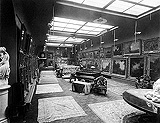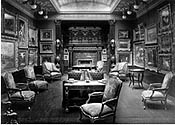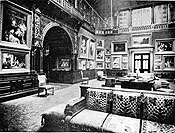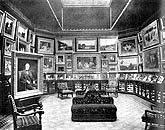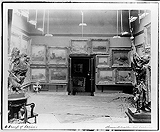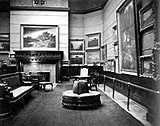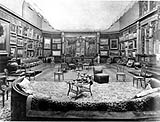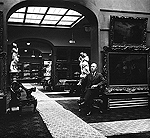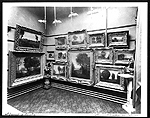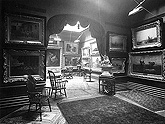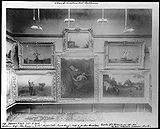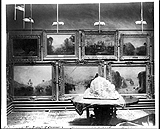The browser will either open the file, download it, or display a dialog.
|
|
Presentation Strategies in the American Gilded Age: One Case Study |
|||||
| I. Presenting a Gilded Age Art Collection The development of an art collection, especially one of substantial size, requires that the collector devise an appropriate setting for displaying the objects. While many American Gilded Age collectors displayed their art works as part of the decor of their homes, those whose collections grew to more than fifty paintings typically found that they needed a separate exhibition space. The realization that a gallery space might be required was gradual. Initially, paintings and sculptures filled up the walls in libraries, music rooms, dining rooms and public gathering spaces such as parlors or ballrooms. It is only as the collection grew that it became apparent that there might be too many objects and too little space to accommodate them. |
||||||
| This was certainly the case with Midwestern lumber baron and art collector Thomas Barlow Walker (or T. B. as he preferred to be called). Although his collection is virtually unknown today, it was one of the largest private art collections in the United States in the early twentieth century. Subsequent de-accessioning by the Walker Art Center, the institution that evolved from T. B.'s original gallery, has obliterated the scope and importance of one of the Gilded Age's most remarkable collecting projects. As a successful entrepreneur with a multi-million dollar business to run, Walker's interest in art evolved gradually. His earliest purchases hung in the family home in downtown Minneapolis, adorning the walls of both public and private rooms purely for the pleasure of his family and friends. By the late 1880s, however, there was more art than wall space and Walker began to design a small gallery addition to his house. In December 1887 he applied for a building permit to construct a modest 589 square foot gallery adjacent to his home.1 It was to house twenty of his best paintings. Before long, even that was insufficient space and Walker significantly enlarged the gallery in the early 1900s, and again in 1913 when he doubled its capacity to nearly 6000 square feet.2 The resulting exhibition space was much more than a private gallery; it was a series of sky-lit rooms filled with paintings, sculptures, carpets, furniture, objets d'art, and comfortable places for myriad visitors to sit and contemplate the art. There was even a piano in one of the center galleries for the occasional musical entertainment (fig. 1). Although exact square footage figures are not available, photographs from the time illustrate that Walker's gallery was, in fact, larger than his home (fig. 2). | ||||||
| T. B. Walkers's art gallery, and his presentation strategies, provide a case study for the practices typically found in private American art collections during the Gilded Age. Although Walker's collection was considerably larger than those of most of his counterparts, his use of French Salon-based display styles, publication of comprehensive catalogues, and active participation in public exhibitions, illustrate the variety of presentation methods available to the Gilded Age collector. Art historical research on late nineteenth century exhibition design and collection presentation is somewhat sparse, although there is a growing awareness of collection formation strategies and patronage patterns in Midwestern museums and cities.3 Unlike most of his contemporaries, Walker opened his gallery to the public at no charge every day except Sundays and holidays, which meant that the collection had to be fully prepared for public display at any time. This accessibility, together with the broad scope of the collection, makes Walker's gallery an ideal case study for Gilded Age presentation strategies. | ||||||
| Lighting the Collection Lighting an art collection was an important concern for Gilded Age connoisseurs just as it is in galleries and museums today. The issues of managing natural light, controlling glare, and highlighting special images were common to all art collectors throughout the United States. On the East Coast, private collections in Pittsburgh, Philadelphia, Boston, and New York were typically lit by skylights and some form of artificial lighting. The Charles Lockhart collection in Pittsburgh is a characteristic example (fig. 3).4 Here the gallery contained an arched stained glass skylight and regularly spaced rows of spherical lighting fixtures delineating the edge of the ceiling. There was virtually no flexibility in this design; cloudy days would dim the gallery significantly and the artificial lights could provide only ambient lighting rather than highlighting or reflected washes of light across the walls. The famous private galleries of New York were no different. William Vanderbilt's Fifth Avenue mansion, for example, included a lavish art gallery lit primarily by a central skylight (fig. 4). Chandeliers and wall sconces provided additional lighting for evenings or cloudy days. Down the street at 961 Fifth Avenue, Mary Stuart, widow of the wealthy sugar refiner Robert Stuart, hired architect William Schickel to design a gallery in the accepted style of the times: a skylight for natural lighting, and a metal ring of gas jets suspended from the ceiling for supplemental artificial lighting (fig. 5).5 Again, there was little flexibility for adjusting the light to suit a particular exhibition or embellish a new acquisition. |
||||||
| Like its eastern counterparts, Walker's gallery space was defined by expansive skylights, each one divided in half by a steel beam that was then subdivided into six panels on each side (fig. 6). The skylights were separated by broad flat sections of ceiling defined by centrally sited overhead fixtures that supplied ambient light on cloudy days and evenings. Suspended fixtures around the edge of the gallery supplemented the overhead lighting so that each section of the wall could be spotlighted. In addition, these fixtures featured adjustable lamps that could be moved up and down the pole to which they were attached; this allowed the curator or collector to control the lighting on individual sections or specific paintings. The flexibility of this system testified to Walker's concern with lighting his collection and doing so with the most sophisticated technology of the time. | ||||||
| Careful attention to lighting was characteristic of other Midwestern collectors as well. In neighboring St. Paul, Minnesota, James J. Hill's gallery sported a combination of skylighting and artificial lighting (fig. 7). Hill's skylight could be modified by rolling out a canopy of woolen serge fabric mounted on an oak platform located immediately below the glass panels. This platform also provided a framework for electric lighting that would supplement the illumination of the gallery.6 The difficulty with this system was that the individual light fixtures were inconvenient to adjust because of their location so close to the skylight; soon after its installation, the oak framework was taken down and reconfigured so that it was within easy reach for adjustments.7 | ||||||
| In Chicago, Potter and Bertha Palmer utilized a similar system to showcase their collection (fig. 8). The central skylight was filtered with a fabric canopy that diffused the daylight on bright days; it was complemented with a system of hanging electric lights that could be adjusted by manipulating the reflector attached to each fixture. This allowed the creation of either a wash of light over a section of the wall or the spotlighting of a special painting. Such flexibility was dependent on an awareness and use of new building technology, both in the installation of steel-framed skylights and the use of the most current lighting systems. It should come as no surprise that Midwestern collectors whose commercial interests were tightly bound to the development of new construction technology were among the earliest patrons of sophisticated lighting systems. | ||||||
| Viewing the Collection Gilded Age art collections, not only in the Midwest but also throughout the country, possessed a distinctive presentation style that was based on the traditional French Salon model. From its founding in the seventeenth century until the last decades of the nineteenth century, the Paris Salon presented art to the public in a style that focused on quantity rather than quality. Paintings were hung from floor to ceiling and corner to corner in a hodge-podge patchwork of genres, styles and sizes. The drawbacks to this approach were obvious: even the most brilliant painting might remain unnoticed in the visual clamor; a subtle work stood no chance at all. This approach, however, remained the standard in the nineteenth century in both museums and commercial galleries. When private collectors began to create galleries in their homes, this was the example to which they turned for guidance. Gilded Age collectors often modified this style by hanging paintings throughout their homes, but when they designed a gallery devoted primarily to the display of art, the French model was almost universally followed.8 |
||||||
| Walker's gallery was no exception. Paintings were stacked in three or four levels, the first one resting on the floor and the others filling the wall up to the ceiling (fig. 9). To contemporary eyes, this floor-to-ceiling approach seems visually chaotic and often incomprehensible. For Gilded Age viewers, however, it was an expected standard that marked a collection as a sophisticated expression of culture. As Walker's collection grew over time, he and his curator, Rueben H. Adams, gradually articulated a more coherent approach to exhibiting paintings.9 Paintings were grouped by stylistic categories, such as Barbizon painting, or by individual artists, such as Cazin, Corot, or Turner. A reviewer in 1919 identified nineteen separate spaces within the gallery, each one defined by an individual artist, a style, or by subject matter. "Entering Gallery "A", the visitor at once is impressed by a glorious assemblage of fourteen Cazins; all landscapes of good size, showing the artistic evolution of this prolific painter in a highly instructive fashion. His earlier searching methods, as well as his later free and broad handling of material, here find expression in a great variety of landscape subjects."10 Similarly, "Gallery D is dominated entirely by the Corots, twelve splendid ones of all sizes dealing with a great variety of subjects (fig. 10)."11 Barbizon artists were grouped together in Gallery C; English portraiture was located in Gallery E; American landscapists were found in Gallery G. The arrangement of paintings by subject or artist was ideally suited to Walker's objective of providing the public with a visual tour of the history of art. Unlike most Gilded Age private galleries, Walker's was clearly designed not only for exclusive social gatherings but also for the cultural edification of the general public. In short, this was essentially a public private gallery. | ||||||
| In addition to categorizing art by subject, nationality, and style, Walker and Adams took pains to hang the paintings around a particular focal point. William Bouguereau's April Showers, a sentimental genre scene depicting two young girls sheltering from a cloudburst, illustrates this approach clearly (fig. 11). To draw attention to this perennial favorite, it was hung on an end wall among a grouping of smaller paintings and placed close to eye level of the average viewer. Furthermore, the central axis of the display was emphasized by placing a small rural genre painting on the floor immediately below the Bouguereau. The viewer could not help but notice this extended axis and, therefore, the ever-popular April Showers. This same design was applied in a slightly different style to the display of Walker's collection of the Breton family paintings (fig. 12). Here the centerpiece was Virginie Demont-Breton's Her Man is on the Sea, a large vertical image that dominated the wall. No less important were the two paintings by Demont-Breton's father, Jules Breton, that flanked the central image: The Last Ray and The Evening Call. These paintings echoed the rural subject matter of Her Man is on the Sea in their emphasis on the dignity of rural people and in the quasi-mystical mood of reverence for the daily cycle of agrarian life.12 The three paintings that hung above the first tier of images also related to the subject of Demont-Breton's work, reiterating the theme of seafaring life as if to give the viewer a glimpse into the mind of the young mother sitting by the fireside dreaming—and hoping that her husband is safe at sea. Although these paintings naturally commanded the viewer's attention because of their size, Walker enhanced their importance by hanging only six works on this wall, thus distinguishing them from the rather cluttered walls elsewhere in the gallery. | ||||||
| Walker's gallery also provided for the physical comfort of the visitor. Chairs and benches were scattered throughout the space, often placed strategically for the best view of a particular work. Oriental carpets, another component of Walker's collection, were strewn generously on the floor, and his modest sculpture collection was placed on table tops and small pedestals where it could best be seen in the context of the paintings surrounding it. Similarly, Walker's well-respected collection of Chinese jade was housed in wood-framed glass cases where visitors could focus on the exquisite carving of the relatively small objects. The one exception to this was the Jade Mountain, a very large carving that was placed on an eighteenth century table in the gallery with Walker's collection of paintings by J.M.W. Turner (fig. 13). This combination of media, styles and cultures was characteristic of private art collections at the turn of the century. The modern tendency to segregate paintings from sculpture and decorative arts, and western art from eastern art, simply wasn't considered during the Gilded Age, perhaps because it would have been decidedly inconvenient for private collectors to organize this type of display, but also because their approach was more comprehensive than exclusionary. The twentieth century modernist belief that 'less is more' would no doubt have bewildered Gilded Age collectors who saw their objective, at least in part, as the attainment of the broadest possible cultural education. For T. B. Walker, it was equally important that his cultural treasures be shared with the general public, regardless of their initial level of education about the arts. | ||||||
| The Printed Word One of the most effective tools that Walker used to present his collection to the public was the printed catalogue. The earliest extant catalogue, dating from 1902, was a straightforward listing of the paintings in the collection. It was a modest publication, measuring 4 x 6 inches, with a mustard-colored embossed stamp titling the piece Supplement to the Catalogue of the Art Collection of T. B. Walker.13 The next edition of the catalogue appeared in 1907, this time bound in black leather with a gilded title and marbled end papers. A soft-cover version was also produced with the same 4 x 6-inch dimensions, but a deep burgundy paper cover and black type.14 It was this catalogue that established the pattern for future publications. It began with a "List of Artists Represented" followed by four pages of "Some Voluntary Comments by Visitors", and then the actual catalogue of paintings.15 In 1912, there was a slight modification to the catalogue with the addition of "Some Voluntary Comments by Art Writers and Visitors", an indication that Walker was hoping to promote his reputation as an aesthetically sophisticated collector.16 This trend continued with the 1916 catalogue where the 'voluntary comments' were made by "Art Critics, Art Writers, Artists and Others."17 Subsequent catalogues were published in 1918, and 1919; in 1925, an extensive catalogue was published by the California Palace of the Legion of Honor in conjunction with an exhibition of Walker's collection in San Francisco.18 Walker's commitment to the regular publication of catalogues and his unceasing updating of the content suggests not only that he believed in the power of good public relations, but also that he hoped to provide an opportunity for the individual visitor to contemplate aesthetic issues and ideas at leisure. Unlike his fellow collectors, Walker did not charge a fee for these catalogues.19 |
||||||
| II. Public and Critical Reception of Walker's Collection Even in his own day, Walker's collection was never viewed as a risky aesthetic adventure. From its inception, it was a public collection, to be shared with the broadest possible community. As a result, there is an abundance of commentary on the collection ranging from newspaper articles to personal letters and critical analysis. In reviewing this material three observations recur consistently: surprise at the quality of the collection; astonishment at discovering such an impressive gallery in Minneapolis; and warm admiration for Walker's open-door policy. |
||||||
|
Newspapers of the era routinely expressed surprise at Walker's collection, and particularly at his willingness to open his gallery to the public free of charge throughout the year. A 1903 article in the New York Herald is representative:
On December 20, 1903, the West Coast San Francisco Bulletin took a similar stand:
Although hyperbole plays a role in this assessment, the general reaction is consistent with other accounts from the time. |
||||||
|
A 1907 Chicago Journal article takes a slightly different approach, providing an evaluation based on civic virtue:
Unfortunately, the Chicago reporter was not entirely accurate in assuming that Minneapolis "acknowledges her gratitude". The public reception of Walker's collection in Minneapolis was tepid at best. Although the Minneapolis newspapers regularly reported new acquisitions in brief notices, and certainly recorded the social activities of the Walker family, there was seldom any discussion of the collection, the quality of the art, or the issues of contemporary aesthetics. The press coverage of Walker's 1912 trip to New York offers a typical example. The New York World, New York Tribune, and New York Herald-Paris Edition all carried articles about Walker's arrival in the city and a description of his purchases from local galleries.23 Walker's acquisition of the Jules Breton painting, The Last Ray, was especially noted by reporters that year, and in fact, this purchase was reported coast to coast, in the Cleveland Plain Dealer, the San Francisco Examiner, the Dayton Journal and the Colorado Springs Gazette (fig. 14).24 Walker's comment about his estimated $1 million in art purchases was recorded in the New York Evening Journal on March 16, 1912: "I have bought all these art treasures to take back to Minneapolis where they can be viewed by the people who do not enjoy the opportunities of travel that fall to the lot of the wealthy classes."25 While this statement might be perceived as marginally patronizing by today's standards, it certainly would not have been unusual in its time. It is mystifying then to discover that only the Minneapolis Journal covered Walker's trip to New York, and that article focused primarily on the family automobile trip from New York to Florida. Only a single sentence suggested that Walker had been engaged in any activity relating to his art collection. "Mr. Walker is assembling the paintings he has purchased in New York during the last year and they will be shipped to Minneapolis in the summer."26 This report could hardly be described as anything more than perfunctory. |
|||||
| The reason for this apparent indifference may lie in the very qualities that engendered admiration in other parts of the country. Walker's lifelong commitment to opening his gallery freely to the public appears to have been virtually unique among Gilded Age collectors, but it gained him no cheerleaders among Minneapolis society. From his earliest years as a civic leader in Minnesota, Walker maintained a public position that culture and education should be available for all people regardless of social class, a position that was decidedly unpopular with those who wished to create social barriers between classes. His early efforts to secure a free public library, combined with his personal commitment to a free and open gallery, offered an obvious example for others to follow. That other leading citizens did not do so may have troubled their social consciences, even if not sufficiently to create change. It should also be noted here that Walker spent a significant portion of the year attending to business outside of Minneapolis, whether it was in New York, Chicago, San Francisco or Crookston, Minnesota. This meant that he was simply not available to participate in the round of social engagements that claimed the attention of other wealthy local luminaries. Similarly, Walker's wife Harriet was primarily concerned with her work as the founder and director of Northwestern Hospital, an organization that she and several other women had developed to serve the needs of 'fallen women'.27 She was not a woman who found society activities either alluring or compelling. No doubt this made it easy for elitist society matrons to dismiss the Walker family as unimportant, and T.B.'s art collecting as the whim of an eccentric millionaire. Whatever the reasons behind the local indifference to Walker's art collection around the turn of the century, it is certain that there is a marked discrepancy between the Minneapolis coverage of Walker's activities and that of other metropolitan centers throughout the country. | ||||||
| Contemporary Critical Response Critical responses to the collection, from a variety of sources including museum directors, curators and educators, were far more supportive. The director of the Royal Ontario Museum, C. T. Currelly, found the collection staggering and described himself as being "carried completely off my feet by what I saw."28 More significant was his observation about the nature of the collection: "One thing that particularly pleased me was the sense of individuality. It was no dealer's collection pushed on a rich man, but chosen by a man who evidently knew what he wanted and was quite willing to wait until he could get it."29 |
||||||
|
S. A. Barrett, curator of the Public Museum of Milwaukee, wrote: "There is no art collection of which I know in this country that can be compared with this collection, except to a certain extent the Metropolitan Museum, which is larger, but is not, taken altogether, nearly so fine and attractive as this one that I find here."30 There may be some Midwestern boosterism in this statement, but it nonetheless reflects the perception that Walker had assembled a major art collection rivaled only by the older, well-established museums on the East Coast. William E. Curtis, an art critic with the Chicago Record Herald who made a special visit to the gallery in September 1911, echoed this sentiment. He filed the following report a month later:
It is important to recognize that Walker's private gallery is most frequently compared with large, public institutions rather than with other private collections. In the mind of art professionals and critics, the Walker Gallery was perceived as a quasi-public organization. |
||||||
| Loaning the Collection Another indicator of the critical reception accorded to Walker's collection is the record of loan exhibitions in which he was asked to participate. Early in his art-collecting career, Walker was an active contributor to the Minneapolis Industrial Exposition Art Exhibit. In 1889, for example, he loaned six paintings, more than any other single collector.32 In 1890 he began the regular practice of loaning works to the new Minneapolis Public Library for the art gallery there.33 The initial loan was seventeen paintings including the popular Demont-Breton work Her Man is on the Sea (fig. 12).34 By 1909, Walker had loaned 111 paintings to the Public Library, in part because he simply had no room to display them all at his gallery, and in part because he wanted to make sure that they were available for both the reading public and the students of the Minneapolis School of Fine Arts which was also located on site.35 Walker was also generous in loaning his collection to the fledgling Minneapolis Society of Fine Arts. In spite of the fact that some of the most vocal 'critics' of Walker's collection were members of the Museum's board of directors, he continued to loan works to the institution when asked.36 No doubt Walker also appreciated the irony of having his opponents request the loan of paintings that they supposedly disdained as unworthy of the people of Minneapolis. |
||||||
|
On the national front, Walker's collection was perhaps even more sought after than at home. Beginning with the purchase of Jules Breton's Evening Call in 1889, Walker's collecting activities were closely noted by art dealers and museum professionals (fig. 15). Before it was even shipped to Minneapolis, the Breton painting was sent to the Art Institute of Chicago at the request of the director.37 In 1909, seventeen paintings were sent to Seattle for inclusion in the Alaska-Yukon Pacific Exposition.38 Four years later in 1913, Walker was working actively on the art exhibit planned for the Panama-Pacific Exposition in San Francisco. The San Francisco Chronicle reported that, in addition to providing paintings from his own collection, Walker hoped to attract loans from other collectors such as J.P. Morgan, Johnson, Widener, Frick, Huntington, Freer, and Hearn for the Exposition.39 | |||||
| The exhibition that most clearly articulated Walker's status as a major collector occurred in 1925 at the California Palace of the Legion of Honor, the very same building that had housed exhibitions for the 1915 Panama-Pacific Exposition. This time, however, the exhibition was devoted exclusively to the collection of T. B. Walker. Over 100 paintings, as well as numerous pieces from the jade and porcelain collection, were shipped to San Francisco. The show opened on July 25, 1925 and the Bay Area newspapers covered it in compulsive detail. The director of the California Palace of the Legion of Honor, Mrs. Cornelia Sage Quinton, reported that she had received 128 paintings and 109 jades, porcelains and pottery, and noted that: "The Cazins and Ziems are considered by many to be the gems of the collection."40 The San Francisco Examiner art critic, Nadia Lavrova, declared that 30,000 people had attended the show in its first few days, and proclaimed, "Those prophets who lament the decadence of good taste to the insidious influence of jazz are not improved on what is happening in the halls devoted to art. Within three days almost thirty thousand San Franciscans confessed their predilection for the classical as they slowly filed through the galleries of the California Palace of the Legion of Honor filled with a collection of paintings and rare objects loaned by Thomas Barlow Walker of Minneapolis, Minn."41 The excitement and enthusiasm generated by this exhibition can hardly be overstated. Not only did every newspaper from Berkeley to San Jose cover the story, but national publications such as the Christian Science Monitor and the New York Times also carried articles about it.42 The show was such a success that the museum extended its hours to include evenings and the city arranged for special bus lines to be added to the transit system.43 By early October over 500,000 people had visited the museum, and Walker was persuaded to extend the exhibition until the end of the year.44 Certainly, Walker could not have asked for a more favorable response to his collection, and it was especially appropriate that he should have enjoyed this warm acclaim in the last years of his life. | ||||||
|
The People Speak
T.B. Walker undoubtedly would have cherished this image of himself. It reflects a genuine admiration for his open-handed generosity, as well as an understanding that his 'unconventional' attitudes distinguished him from the stereotype of the elitist capitalist money-grubber.46
From a less famous source, a Richmond, Virginia attorney, came this brief note: "I have brought back from Minneapolis unfading memories of the most wonderful art gallery in America collected by a private individual. The hours spent day after day among your treasures have made an indelible impression upon my life, and I shall never cease to honor and admire the genius and philanthropy which has done so much not only for Minneapolis but for all America."48 And finally, a more modest letter came from Mrs. Hanna L. Toff of Des Moines, Iowa on September 10, 1912: "I feel I must thank you for the great privilege your wonderful generosity in throwing open to the public your extraordinary art gallery affords to rich and poor alike, so they can all enjoy the masterpieces. To think that I have been able to look upon them, for you might say the asking, and to have the privilege of meeting and talking with the man who collected them, that is indeed a privilege I little expected."49 It's not an elegant letter, or even a well-written one, but the feeling is very sincere. This was what T. B. Walker hoped for when he opened his gallery to the public. |
||||||
| III. Conclusion Not surprisingly, presentation strategies in private Gilded Age art galleries reflect the characteristics of the entrepreneurial patrons who formed the collections. Technological innovation, commercial savvy, social consciousness, and a dependence on Parisian leadership in design and style are the hallmarks of presentation strategies in private art galleries. In T. B. Walker's gallery, technological innovations such as flexible lighting systems provided visitors with a well-lit viewing environment, while fashionable furnishings offered a comfortable place to sit and contemplate particular pieces. Marketing strategies most commonly found in a business context, such as printed catalogues, were used to educate visitors about art and to create a public image of a sophisticated and erudite patron. In contrast, the installation of the collection relied heavily on the example set at the Paris Salons where paintings were hung edge to edge and floor to ceiling. Walker modified this style only slightly by grouping paintings thematically or by individual artists. |
||||||
| Walker's social consciousness found expression in his free and open admission policy, his provision of free comprehensive catalogues of the collection, and his willingness to loan his paintings to a variety of institutions. It is too easy to interpret this generosity only in terms of projecting a benevolent public legacy, although Walker no doubt hoped that he would be remembered as a patron of the arts. However, such generalizations trivialize Walker's lifelong commitment to public education and his willingness to fight for public access to all forms of art and learning, whether in the form of the Minneapolis Public Library or, ultimately, the creation of the Walker Art Gallery (today the Walker Art Center). He could easily have donated his collection to San Francisco where it would have been genuinely welcomed; instead, he chose to stand fast in his belief that the people of Minneapolis, if not the city officials and local nabobs, would value his gift and expand their understanding of the world as a result of it. | ||||||
|
1. Clara Nelson, "A Lifetime Burning", (unpublished biography of T. B. Walker), p. 481. Courtesy of the Walker Art Center, Minneapolis, Minn. See also Janet Whitmore, Painting Collections and the Gilded Age Art Market: Minneapolis, Chicago and St. Louis, 1870-1925, (PhD. diss., University of Minnesota, 2002). 2. Minneapolis Tribune, May 8, 1913. According to the newspaper report, Walker had just started construction of a fifth addition to the gallery. 3. See Gabriel Weisberg, ed., Collecting in the Gilded Age: Art Patronage in Pittsburgh, 1890-1910. (Hanover and London: Frick Art & Historical Center; University Press of New England, 1997). This is one of the few scholarly publications on the topic of patronage in the Gilded Age. 4. Ibid., pp. 77-82. 5. Arnold Lewis, James Turner, and Steven McQuillin, The Opulent Interiors of the Gilded Age, (New York: Dover Publications, 1987), p. 103. 6. Thomas O'Sullivan, "Showcase and Stronghold: The Art Gallery of the James J. Hill House" Homecoming: The Art Collection of James J. Hill, (St. Paul: Minnesota Historical Society Press, 1991), pp. 54-56. 7. Ibid., p. 55. 8. Both the Hill collection and the Palmer collection were presented in this style, as were the Vanderbilt and Stuart collections. Similarly, museum exhibitions in such institutions as the Metropolitan Museum of Art in New York, the Boston Museum of Fine Arts, or the Art Institute of Chicago also utilized the same presentation technique. In short, the "floor-to-ceiling" display of art was broadly accepted. 9. Rueben Adams was a trusted employee of the Red River Lumber Company before he assumed curatorial responsibility for Walker's art collection. Adams had no formal training as a curator, but he did have an active interest in the subject and a willingness to learn on the job. Equally important, Walker trusted him with the administration and management of the collection during the long months when he could not devote his personal attention to it. Although the exact date of Adams appointment as curator is not documented, it is likely that he began in the last years of the nineteenth century. The catalogues published in 1902, 1907, 1909, 1912, 1913, 1916, 1918, 1919 and 1925 all indicate that someone spent considerable time assembling and organizing the text. Since Adams is given credit for this work beginning with the 1912 catalogue, it is reasonably safe to assume that he was responsible for the earlier versions as well. There is no doubt that T.B. Walker would not have been able to dedicate the necessary time for such an endeavor in the years when he was actively involved in business. 10. Eugen Neuhaus, Report on the Paintings of the T.B. Walker Art Collections, (n.p.:Minneapolis, 1919), p. 4, Walker Art Center Archives. Neuhaus, a professor of art history at the University of California-Berkeley and at Mills College, conducted an evaluation of the collection at Walker's request as part of an assessment of the quality of the collection, stimulated by Walker's desire to donate it, in its entirety, to the City of Minneapolis. 11. Ibid., p. 9. 12. For further information on Jules Breton, see Annette Bourrut-Lacouture, Jules Breton, Painter of Peasant Life (New Haven:Yale University Press, 2002). 13. Supplement to Catalogue of the Art Collection of T. B. Walker, (Minneapolis, 1902). The numbering system for the paintings listed here begins at 179 and runs through 206. Obviously, this was intended as a continuation of an earlier catalogue no longer available. 14. Catalogue of the Art Collection of T.B. Walker, (Minneapolis, 1907), Walker Art Center Archives. The production of two markedly different covers for the 1907 catalogue suggests that Walker printed one version for general distribution and one for a selected audience. The economies of scale should also be noted in this context since he would have printed both versions at the same time, thus saving on the printing costs. 15. Ibid. 16. Descriptive Catalogue of the Thomas B. Walker Art Collection, (Minneapolis, 1912) Walker Art Center Archives. 17. Alphabetical List of Artists and Paintings in the T. B. Walker Art Collection, (Minneapolis: C.H. Dahlen Printing Company, 1916), Walker Art Center Archives. 18. California Palace of the Legion of Honor, Catalogue, Art Collection of the Honorable T.B. Walker, Minneapolis Minnesota, (California Palace of the Legion of Honor, San Francisco, 1925). The San Francisco exhibition took place when Walker was constructing his new art gallery on the edge of downtown Minneapolis, on the site where the Walker Art Center stands today. Because of the disruption caused by construction, it was convenient for Walker to send a large number of paintings to San Francisco. 19. Walker's insistence on providing free catalogues to all visitors was unique in the Twin Cities. James J. Hill, who closely regulated admission to his gallery, charged a small fee for the catalogue of the collection. See Homecoming, pp. 56-57. Even The Minneapolis Institute of Arts, which opened its new building in 1915, charged an admission fee of $.25 during the week although admission was free on Wednesdays, Saturdays and Sundays. See The Minneapolis Institute of Arts, The Inaugural Exhibition, January 7 to February 7, MCMXV (Minneapolis: Byron Printing Company, 1915). 20. New York Herald, Sunday, March 1, 1903. 21. Bulletin, San Francisco, December 20, 1903. 22. Chicago Journal, May 16, 1907. 23. New York World March 14, 1912, New York Tribune, March 14, 1912, New York Herald-Paris Edition March 17, 1912. 24. Cleveland Plain Dealer, March 24, 1912; San Francisco Examiner, March 24, 1912; Dayton Journal, March 31, 1912; Colorado Springs Gazette, April 5, 1912. 25. New York Evening Journal, March 16, 1912. 26. Minneapolis Journal, March 14, 1912. 27. Biographies of Thomas B. Walker and Harriet G. Walker of Minneapolis, Minn. , (New York: James + White + Company, 1915). In contemporary terms, Harriet Walker served as the Chief Executive Officer of the fledgling Northwestern Hospital. As the organization grew, it offered not only medical services for women, but also a nursing school to train young women in the profession. The staff of the school, including the physician instructors, were all female, a radically unusual approach in turn-of-the-century Minneapolis. Harriet was a devout Christian and temperance advocate, but she seems to have been one of those rare individuals who quietly lived her beliefs without fanfare. Like her husband, she was more widely recognized outside of Minneapolis than at home. In 1893, she presented a paper on "Dr. Keeley and the Temperance Work" at the World's Temperance Congress held in conjunction with the World's Columbian Exposition in Chicago. She advocated a combined medical and spiritual approach to the treatment of alcoholism, a methodology that has since proven to offer a sound therapeutic approach to this disorder. Her legacy, which deserves much additional study, is Abbott-Northwestern Hospital, today one of the Twin Cities leading medical institutions. 28. Letter from C. T. Currelly April 4, 1918, The T. B. Walker Art Collection (Minneapolis, 1919), Walker Art Center Archives. 29. Ibid. 30. Letter from S. A. Barrett to T. B. Walker, Walker Art Center Archives. 31. William E. Curtis, "Walker Gallery One of Greatest Art Collections", Chicago Record Herald, October 11, 1911. 32. Minneapolis Industrial Exposition 1889, Catalogue of Paintings and Casts from the Antique, Etc. (Minneapolis, Ransdell Eng.Co., 1889), pp. 9-12. The six paintings were: Daily News Reading before the Barber Shop of Licinius and Pleasant Hours in the House of Lucullus, both by Boulanger; Haydn's Inspiration for the Seasons and Creation by Edward Jean Conrad Hamman; Waiting for the Boat by Emil Claus; Christian Pilgrims at the Tomb of the Holy Virgin at Jerusalem by LeComte de Nuoy; and Hamlet and Ophelia by J.M.A. Gabriel Ferrier. 33. The Minneapolis Public Library moved into its own building on Hennepin Avenue and Tenth Street in 1889, thanks in large part to the tireless efforts of its Board President, T.B. Walker. Minneapolis Public Library, Minneapolis Public Library, Fifty Years of Service, 1889-1939, (n.p.: Minneapolis: 1939), p. 4. 34. Collection of Paintings in the Art Gallery of the Minneapolis Public Library (Minneapolis, 1890) n.p. 35. Minneapolis Public Library, Fifty Years of Service, 1889-1939, p. 36. 36. Letter to Archie Walker, June 16, 1922. The Minneapolis Institute of Arts, Director's Correspondence File: Loans, 1922. The letter, which is unsigned but initialed GSH thanks Archie Walker for the loan of an unspecified number of paintings. 37. Letter from R. F. Knoedler to T. B. Walker, February 18, 1890. Walker Art Center Archives. 38. Minneapolis Tribune, May 14, 1909. 39. San Francisco Chronicle, "Art Collectors May Exhibit Here", February 23, 1913. The success of Walker's promise to solicit other collectors for donations cannot be assessed, but the Exposition program lists a vast number of artists and paintings on display at the Fair. See the Official Catalogue (Illustrated) of the Department of Fine Arts (San Francisco: The Wahlgreen Company, Official Publishers to the Panama-Pacific International Exposition, 1915). 40. San Francisco Chronicle "Walker Art Group to be Shown Here" July 20, 1925. 41. Nadia Lavrova, San Francisco Examiner "30,000 View Paintings at Art Palace", July 29, 1925. 42. The Christian Science Monitor ran two articles on the exhibition, the first on June 25, 1925 to announce the opening, and the second on August 10, 1925. The New York Times reported briefly on the opening on July 26, 1925. The newspaper coverage in the Bay Area was exhaustive with the San Francisco Chronicle, the San Francisco Examiner, the San Francisco Daily News and the Oakland Tribune running numerous articles on all aspects of the exhibition from the planning stages until after its closing. 43. The San Francisco Bulletin carried the announcement that the Palace of the Legion of Honor would be open at night, September 5, 1925. The San Francisco Examiner and the San Francisco Chronicle reported the additional bus lines on September 26, 1926. 44. San Francisco Examiner, "Half Million View Walker Art Exhibit" October 4, 1925. 45. Mississippi Valley Lumberman, June 10, 1902. 46. Although it is beyond the scope of this study to analyze Walker's business practices, it should be noted that his concern for public welfare also extended to his commercial dealings. In a 1903 speech, he condemned the practice of creating trust monopolies in business, saying that: "…the trust is not an economic necessity, but merely the outgrowth of greed for power and money." In addition, he maintained that the argument for trusts being a more economical method of doing business was specious and unprincipled. Minneapolis Journal "An Encouraging View of Trusts," May 12, 1902. No one should think that T. B. Walker was anything other than a very successful capitalist, but he seems to have sincerely tempered his business practices with a strong set of ethics anchored deeply in his Methodist faith. 47. The T. B. Walker Art Collection Letters, (Minneapolis, 1923), p. 5. 48. Ibid., p. 9. The letter was written by Eugene C. Massie of Richmond, Virginia. 49. The T. B. Walker Art Collection (Minneapolis, 1919), Letter dated August 1914, p. 34. |


